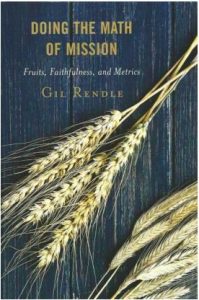Doing the Math of Mission: Fruits, Faithfulness, and Metrics, by Gil Rendle. Reviewed by Jeremy Fagan
Doing the Math of Mission: Fruits, Faithfulness, and Metrics, by Gil Rendle
Rowman & Littlefield, 2014, vii + 147pp, ISBN 978-1-5669-722-5, £9.99.
Reviewed by Jeremy Fagan
 Gil Rendle has extensive experience of churches through his work with the respected Alban Institute. He starts this helpful little book by asking, Can ministry be measured in mathematical proportions? To hear reports and news stories appearing regularly in the news and in church publications, the answer is an obvious Yes, but to many in the church, it seems mechanical and utilitarian to try to count changed hearts and lives. While he is wary of the dangers, and is aware that in many ways we currently get it very wrong, Rendle argues that if we don’t measure anything, there’s a risk that we won’t get anything.
Gil Rendle has extensive experience of churches through his work with the respected Alban Institute. He starts this helpful little book by asking, Can ministry be measured in mathematical proportions? To hear reports and news stories appearing regularly in the news and in church publications, the answer is an obvious Yes, but to many in the church, it seems mechanical and utilitarian to try to count changed hearts and lives. While he is wary of the dangers, and is aware that in many ways we currently get it very wrong, Rendle argues that if we don’t measure anything, there’s a risk that we won’t get anything.
In six short chapters, Rendle takes us through the why and how we measure, how we decide on what we measure against, and offers some tools that we might use, finishing with some cautions that should be observed. He writes from a US Methodist context, but it is easily transferable.
Rendle uses Deming’s thinking on systems to distinguish between counting and measuring. If any system has inputs, activities and outputs or outcomes, then counting asks the ‘how many’ questions of inputs and activities, paying attention to numbers. Measuring attends to the outcomes of the system, asking the ‘how far’ questions around change. This has resonances of Peter Robertson’s work in Always Change a Winning Team (Cyan, 2005) around feedback and feedforward systems in change – feedback measures what has happened already to improve it, feedforward describes where we want to be in the future.
‘A common nonprofit dilemma [is that] nonprofits routinely do not know what difference they are trying to make.’ If the purpose of a pastor and a congregation is to make a difference, something has to have changed. Rendle contrasts the vision statement – our ideal church – with the outcomes to be measured, which should be the realistic next step(s), and should include a time limiting element.
The two approaches will lead to different questions. Counting about the church as the object of our attention, how many attend, how much money do we have, how can we get more people, etc. Measuring, instead, focuses the question on the church as the instrument of God’s love in its context: here conversations should be about discernment, discovering possibilities and dreaming. These conversations will be energising instead of draining.
Scripture, and examples from the Grameen Bank, RISE, and Rendle’s own ministry are given to illustrate his point. He gives several different tools as examples of ways that outcomes can be measured, including Apgar scores, Likert scales, and Cascading Questions. However, he doesn’t offer any examples of how these have been used in practice, which I would have liked to see.
In short, this should be required reading for Archdeacons and their equivalents when visiting congregations, and for anyone trying to work out whether, to borrow Rendle’s language, their church is ‘vital’.
Jeremy Fagan is Team Rector of Kirkby and a student on Sarum College’s MA in Christian Approaches to Leadership.
This review appears in MODEM Matters Issue 30, dated September 2015.